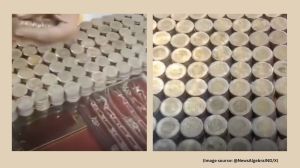Gall bladder can make insulin,help in diabetes therapy: Pune lab study
Gall bladder cells can potentially produce insulin raising the possibility that a persons own cells can be used in stem cell therapy for the disease....
Gall bladder cells can potentially produce insulin raising the possibility that a persons own cells can be used in stem cell therapy for the disease,according to research by a team of scientists at the Pune-based National Centre for Cell Science and the Centre for Regenerative Medicine at the University of Bath,UK.
The findings of the team will be published in the US
Journal of Endocrinology and Journal of Cellular and
Molecular Medicine.
Diabetes develops when pancreatic beta cells are no longer capable of releasing the amounts of insulin needed to regulate blood glucose. This reduces the quality of life and increases risks of serious complications for more than 170 million people worldwide. Even as diabetes researchers have been looking for ways to replace the insulin-producing cells of the pancreas that are destroyed by the patients own immune system,the stem cell technique is now being recognized as a potential treatment for reversing Type 1 diabetes mellitus in humans.
In Type 1 (juvenile) diabetes,the bodys immune system attacks and destroys insulin-producing beta cells in the pancreas. This can be treated by islet transplantation where islets (containing beta cells) are taken from a donors pancreas and transferred to the patient. There are not enough donor organs and researchers are investigating whether stem cells might help this problem of supply.
The generation of insulin-producing cells is therefore a major objective in the long term goal of curing diabetes, says NCCSs Anandwardhan Hardikar,one of the scientists in the team. Alternative sources of pancreatic beta cells include existing pancreatic cells,embryonic stem cells and cells from other tissues such as liver. Hardikar says his teams study has found the gall bladder epithelium as a new source of beta cells.
Hardikar and his colleague Subhshri Sahu tied up with local gastroenterologist Ramesh Dumbre and collected samples of gall-bladder tissue from patients. In one such patient,a diabetic for 12 years she took insulin injections an ultrasound revealed presence of gall stones. Routine histochemistry showed insulin-producing cells were retained in her gall bladder.
The presence of such cells has been documented in mice but not humans,said Hardikar,and thats why the latest study is so significant. A UK-India Educational Research Initiative has been set up with Baths David Tosh as the principal investigator.
Stem cells are in the forefront of research for diabetes, said Anoop Mishra,director,diabetes and metabolic diseases department at New Delhis Fortis Hospital. This discovery by Pune scientists is another in the series of investigations on this topic. Till now,however,practical treatment of Type 1 diabetes,and also Type 2 diabetes with stem cells has met with limited success. It takes a long time to convert research from petri dish to patients and,I am sure,it will be a while for this finding to translate into useful treatment in a cost-effective manner.








- 01
- 02
- 03
- 04
- 05























